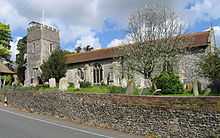Staple, Kent
| Staple | |
 Church of St James the Great, Staple |
|
 Staple |
|
| OS grid reference | TR272566 |
|---|---|
| District | Dover |
| Shire county | Kent |
| Region | South East |
| Country | England |
| Sovereign state | United Kingdom |
| Post town | Canterbury |
| Postcode district | CT3 |
| Police | Kent |
| Fire | Kent |
| Ambulance | South East Coast |
| EU Parliament | South East England |
| UK Parliament | Dover |
Coordinates: 51°15′50″N 1°15′19″E / 51.2639°N 1.2553°E
Staple is a small village and civil parish in east Kent. It lies southwest of the nearby village of Ash and the town of Sandwich and east of Canterbury.
History
The village is three miles west of the Bronze Age site at Ringlemere and east of the Roman and Mesolithic sites at Wingham. The village church, dedicated to St. James the Great, dates to the Saxon period but there have been Bronze Age finds in the land surrounding the village. Staple is situated near the end of one of the arms of the Wantsum Channel, all that survives of which is the Durlock stream (possibly derived from the Celtic *duro- "settlement" and *loccu- "lake, pool", attesting the presence of the former channel). In prehistoric times this channel would have provided access to the sea.
Staple is a Middle English word, signifying an official market for purchase of goods for export; it derives from Anglo-Norman estaple, "market-place",[1] The "staple" of Staple was wool, exported to the Low Countries. The 1283 'Statute of Acton Burnell' (1283) removed the Staple from Calais to fifteen appointed places in England, Ireland and Wales. The royal appointment decreed that 'All wool for export should be gathered at the Staple, if not the selling there.' In the reign of Edward III the Staple was temporarily removed to Queensborough on the Isle of Sheppey; its return nine years later was occasioned by the greater ease with which export to Calais was effected, by Staple's proximity to Sandwich. The Staple system suffered a long slow decline, and was abolished in 1617. Another export product from Staple was leather.
From 1916 to 1948 the village was served by Staple railway station on the East Kent Light Railway, which was north of the village at Durlock Bridge. In World War II the station was used as a munitions dump, and a large-calibre rail-mounted gun was stabled there.
There are two gentlemen's seats at Staple, Crixhall and The Groves. The oldest established vineyard in East Kent (1993) is at Staple.
A Fayre was held twice a year, on December 28 and July 25. There were 'toys and pedlary' for sale. Profits from the December Fayre in 1524 amounted to six shillings and eight pence, and were received by one Clement Roberth of Wingham (history: staple-online).
Edward Hasted mentions that fairs were held on 25 July. These were held in a field near The Three Tuns.
The Country & Craft Fayre
Unlike the fairs of old, the present day fairs are held on The Recreation Ground(on either the 3rd od 4th Sunday of June 11:00-4:00).
Staple's Country & Craft Fayre has been staged every year for over two decades. It is organised/managed by a small committee of local people.
The aims of the Fayre are threefold: Firstly, to provide a great day's, value for money event for the people of Staple and its environs. Secondly, to help promote community cohesion. And thirdly, to raise funds for donating to local organisations and charities. (e.g. Staple W.I., Staple Youth Club, Staple Parent & Toddlers, Staple Pre-School, Staple RBL, Staple Woodland Trust and Staple Church).
The Fayre comprises three main elements: Arena-based entertainment, sideshows and craft stalls. Each year, attractions are added/deleted, in order to keep the event fresh and up-to-date. However, there are core attractions which are repeated each year. These include: Competitions (Tossing The Bale and 'It's a Knockout'), Beer Tent, Barbecue, Ice Creams, Soft Drinks, Refreshments Ploughman's Lunches, Teas, Coffees, Rolls etc.), Bric a Brac, Gymnastic Displays, Classic Car Displays, Rural Craft Displays (pole lathe, spinning etc.).
The 2014 Staple Country & Craft Fayre June 22nd) Included: Fairground Rides, Two Classic Car Club Displays, Honda Goldwings, A Hot Doughnut Stand, Two Ride-on Miniature Steam Engines, a Pony and Cart Ride, Candy Floss, Face Painting, Newfoundlands, A rustic Trug Maker, a Stonemason, Jugglers, Fire Eaters, Stilt-Walkers, a Brass Ensemble and lots more. This year's event made a staggering £9,200 profit! (All profits are distributed in the form of donations to Staple's group's and organisations).
The Village Hall
'Staple Village Hall & Recreation Ground' is a registered Charity. Date of Registration: 6 June 1979 Charity Number: 277915
The Village Hall is owned by Staple Parish Council and is managed on behalf of the parishioners by a committee of elected members, plus appointed representatives of village organisations.
The funding for Staple Village Hall was made available through a grant of £123,500 from ACRE (Action for Communities in Rural England). ACRE was awarded £10.5 million by The Millennium Commission to deliver funding for 160 Village Halls in England. The Millennium Commission was a legacy body of 'The Big Lottery Fund'.
Notes
- ↑ The American Heritage Dictionary of the English Language, 4th ed., 2000; Henry Harrison, Surnames of the United Kingdom: A Concise Etymological Dictionary s.v. "Staple".
References
Further reading
- Newman, John, North East and East Kent (series Buildings of England) (Yale University Press) 1969.
External links
![]() Media related to Staple, Kent at Wikimedia Commons
Media related to Staple, Kent at Wikimedia Commons
| |||||||||||||||||||||
